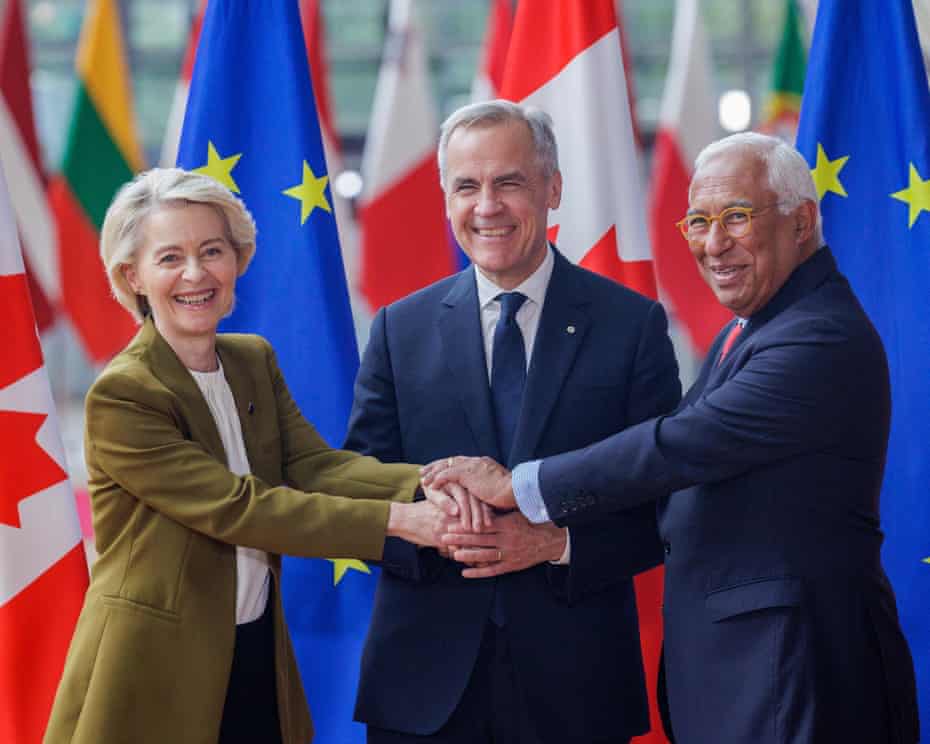Canada has signed a landmark security and defence pact with the European Union, in a move widely seen as a strategic shift by traditional US allies seeking greater autonomy in the face of global instability and a turbulent American presidency.
Canada, EU reps meet
Canadian Prime Minister Mark Carney joined European Commission President Ursula von der Leyen and European Council President António Costa in Brussels on Monday to formalise the wide-ranging partnership. The agreement includes closer cooperation on defence, artificial intelligence, the climate crisis, and continued support for Ukraine.
At a warm and optimistic press conference, Carney declared Canada “the most European of the non-European countries,” adding that the nation “looks first to the European Union to build a better world.” Costa echoed the sentiment: “The European Union and Canada are among the closest allies in the transatlantic space. We see the world through the same lens. We stand for the same values.”
Conspicuously absent from the event was any mention of US President Donald Trump, whose disdain for traditional allies has added urgency to efforts by the EU and Canada to deepen their already robust relationship. Trump is expected to attend a two-day NATO summit in The Hague beginning Tuesday, where member nations are under pressure to commit 5% of their GDP to defence.
Carney, who swept to power in April with a decisive mandate, campaigned on keeping Canada from becoming “the 51st US state,” a notion Trump has flirted with in the past. Speaking in Brussels, Carney described the agreement as part of a broader vision to “diversify and strengthen our international partnerships” in what he called “a hinge moment of history.”
“This is a time when the rules-based international order is under threat. The world is more dangerous and more divided,” Carney said.
The newly signed pact paves the way for Canada to join the EU’s fledgling €150bn defence fund, known as SAFE (Strategic Armament for Europe), marking a significant step in Canadian-European defence integration. Von der Leyen said the agreement would lead to “joint capabilities, interoperability and procurement,” specifically referencing air defence.
“The access of Canada to our joint procurement in the European Union, the door is open,” she stated, adding that negotiations for Canadian participation in the scheme would begin “swiftly.”
The security arrangement mirrors a similar deal the EU recently struck with UK Prime Minister Keir Starmer. While the EU has existing defence partnerships with countries such as Norway and Japan, this is the first of its kind with a country in the Americas. The deal includes cooperation on cyber, maritime and space security, arms control, and military support for Ukraine.
Although participation in joint procurement under the SAFE programme requires a further technical agreement, the political commitment from both sides is clear. Carney said the pact would allow Canada to “deliver on our new capabilities more rapidly and more effectively,” a crucial point for a country currently lagging behind its NATO peers. In 2024, Canada spent just 1.37% of its GDP on defence, far short of NATO’s 2% target.
The new agreement builds upon an already strong economic relationship. The EU and Canada share a €125bn trading partnership, anchored by the Comprehensive Economic and Trade Agreement (CETA) signed in 2016, which eliminated 98% of tariffs. However, the deal has yet to be ratified by 10 EU member states, including Belgium, France, Italy, and Poland, leaving certain provisions in limbo.
Before the summit, Carney and his wife, Diana Fox Carney, visited Schoonselhof military cemetery in Antwerp, where 348 Canadian soldiers are buried. On social media, Carney paid tribute to the “brave young soldiers who ventured across the Atlantic to defend the freedom of Europe.”
They were joined by Belgian Prime Minister Bart De Wever, a former mayor of Antwerp. The couple laid wreaths at the cemetery, and De Wever’s son performed the “Last Post” in a solemn tribute covered by local newspaper Het Nieuwsblad.



